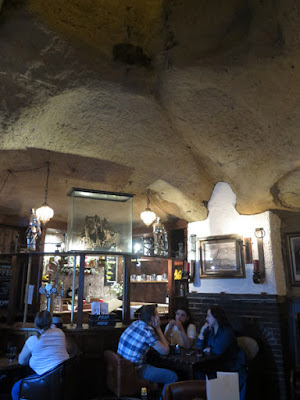 |
| A detail of the Chester Formation on Newcastle Drive |
At the end of a very long day out in Nottingham on the Easter weekend in 2019, I finished my exploration of the city by having a good look at various outcrops of the Lower Triassic sandstone that was known as the Bunter Pebble Beds, and then subsequently renamed as the Nottingham Castle Sandstone Formation and – very confusingly – the Chester Formation.
 |
| The Chester Formation in central Nottingham |
The sandstone was formed by the erosion of the Variscan mountains that lay to the south of what is now Britain 250 million years ago and deposition took place in a huge braided river system that spread across the semi-arid inland basins occupying much of southern, north-western and north-eastern England.
 |
| Castle Rock by the East Midlands Geological Society |
Several outcrops of this pale brownish coloured medium grained and poorly cemented sandstone are found around the spectacular Castle Rock, with very many horizons being rich in well-rounded pebbles of red/brown quartzite and white vein quartz.
 |
| Rock exposures adjacent to The Tunnel |
While wandering around The Ropewalk area, which lies near to the western edge of Castle Rock, I was particularly interested to see that many of the houses are built near to the edge of the cliff and back gardens drop steeply to The Park below. Although I couldn’t gain access to it, this includes a house whose rocky foundations adjoin the Park Tunnel, completed in 1855 for the Duke of Newcastle and where fine examples of cross-bedding can be seen.
 |
| An exposure of the Chester Formation on Newcastle Drive |
Along Newcastle Drive, a large length of a brick retaining wall covers much of the sandstone but, here, there is a good opportunity to study various sedimentary structures and the wide range in lithology of the various pebbles that are found in the sandstone. Also, one stretch of the rock contains numerous cavities, which reminded me of burrows that are made by sand martins.
 |
| Sand martin burrows on Newcastle Drive |
Continuing with my investigation of the area, I arrived at Lenton Road, which runs below the northern part of the curtain wall to Nottingham Castle - where another extensive exposure of the Chester Formation can be seen.
 |
| The Chester Formation on Lenton Road |
I didn’t take a close look at this, as I was more interested in the efflorescence at the base of the retaining wall below Royal Standard House, which I assume are related to the high content of soluble of minerals in the sandstone behind it.
 |
| Efflorescence in the retaining wall below Royal Standard House |
Walking back up to the top end of Castle Road, I then carried on down past the Robin Hood sculptures on the east side of Castle Rock, where various caverns have been excavated into the rock, and finished my day at Ye Olde Trip to Jerusalem.
 |
| An exposure of the Chester Formation on Castle Road |
Reputed to be the oldest public house in England, many of its labyrinth of rooms occupy several similar excavations that, along with the nearby Mortimer’s Hole that descends from the castle above and many others under the city, form one of the most interesting features of Nottingham. When having a drink here, it is always advised to place a beer mat on top of the glass – because it stops the constant fall of sand.
 |
| Ye Olde Trip to Jerusalem |
On this occasion, having walked several miles and taken more than 700 photographs, I sat outside on an exceptionally warm spring night, put up my feet – which had by now begun to ache – and relaxed with a couple of pints of Abbot Ale, before catching the train back to Sheffield.
 |
| A pint of Abbot Ale at Ye Olde Trip to Jerusalem |
No comments:
Post a Comment